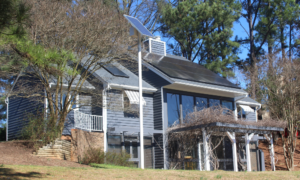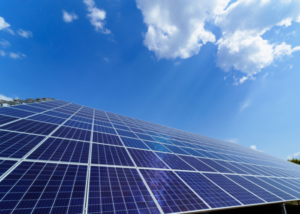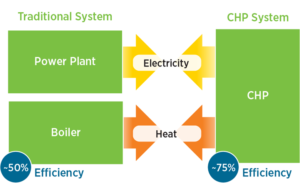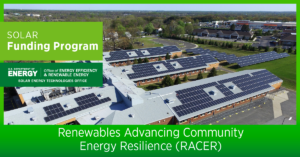35 Years of NCCETC: Clean Power & Industrial Efficiency Program
 In 2023, the North Carolina Clean Energy Technology Center (NCCETC) at NC State University is celebrating its 35th anniversary. Over the last 35 years, NCCETC has worked closely with partners in business and industry, government, academia and the non-profit community while evolving to include a greater geographic scope and array of clean energy technologies.
In 2023, the North Carolina Clean Energy Technology Center (NCCETC) at NC State University is celebrating its 35th anniversary. Over the last 35 years, NCCETC has worked closely with partners in business and industry, government, academia and the non-profit community while evolving to include a greater geographic scope and array of clean energy technologies.
The NCCETC was originally founded as the North Carolina Solar Center in December 1987. The Solar Center began as a partnership between the State of North Carolina, members of the North Carolina Sustainable Energy Association and the College of Engineering at North Carolina State University to promote the development of the solar energy industry. While NCCETC has remained dedicated to its original mission since inception, it has expanded the scope of its activities over time to include a wider array of clean energy activities, and the individuals on the Center’s Clean Power and Industrial Efficiency (CPIE) team provide the technical expertise to support this mission.
Starting with Solar
 The origins of NCCETC lie in the Solar House on NC State University’s Campus. The Solar House was originally constructed in 1981 as part of an interdisciplinary collaboration within the College of Engineering under the leadership of principal investigators Herbert Eckerlin and Al Boyers in Mechanical and Aerospace Engineering, and Ray DeBruhl in Civil Engineering.
The origins of NCCETC lie in the Solar House on NC State University’s Campus. The Solar House was originally constructed in 1981 as part of an interdisciplinary collaboration within the College of Engineering under the leadership of principal investigators Herbert Eckerlin and Al Boyers in Mechanical and Aerospace Engineering, and Ray DeBruhl in Civil Engineering.
It was designed to incorporate readily available solar and energy-efficient technologies to serve three primary purposes: (1) to demonstrate how solar and energy-efficient technologies can be effectively incorporated into a solar house of traditional design typical of the region; (2) to serve as an educational resource and laboratory for students, clubs, professional organizations and the general public; and (3) to serve as a research laboratory for graduate students in engineering, architecture, interior design and other related disciplines.
In the 35 years since its founding, NCCETC has evolved into an organization with much more diverse capabilities and services. As the Center evolved, it included coverage of other technologies key to the growth of distributed energy, namely combined heat and power, solar plus battery storage, off-shore wind energy, district energy and microgrids.
 Larry Shirley, the founding Executive Director of NCCETC, previously discussed how NCCETC helped facilitate the introduction of solar photovoltaic (PV) into North Carolina’s public marketplace. “We found that people in both urban and rural areas supported solar so we started doing workshops, conferences and events which eventually led to the Solar Communities Program,” said Shirley.
Larry Shirley, the founding Executive Director of NCCETC, previously discussed how NCCETC helped facilitate the introduction of solar photovoltaic (PV) into North Carolina’s public marketplace. “We found that people in both urban and rural areas supported solar so we started doing workshops, conferences and events which eventually led to the Solar Communities Program,” said Shirley.
The Solar Communities Program began in Forsyth county in 1989 and, throughout the 1990s, programs were held in Buncombe, Transylvania, Henderson, Forsyth, Guilford, Wake, and Watauga counties. The program extended the services of the Center into communities across the state by teaming up with the country office of the NC Cooperative Extension Service to staff a steering committee of local leaders and energy professionals to guide the selection and execution of demonstration programs in their region. In 1991, the Solar Communities Program earned the National Environmental Achievement Award by Renew America.
Transforming Solar Markets
 Keith McAllister, an electrical engineer, joined NCCETC in September 2004 as a Program Manager for Clean Energy Applications. Under his management, the Solar America Board for Codes and Standards (Solar ABCs) was established as part of a collaborative effort funded by the U.S. Department of Energy. “We formed the Solar ABCs to support the centralized development of codes and standards to accelerate adoption of solar PV systems,” said McAllister.
Keith McAllister, an electrical engineer, joined NCCETC in September 2004 as a Program Manager for Clean Energy Applications. Under his management, the Solar America Board for Codes and Standards (Solar ABCs) was established as part of a collaborative effort funded by the U.S. Department of Energy. “We formed the Solar ABCs to support the centralized development of codes and standards to accelerate adoption of solar PV systems,” said McAllister.
The purpose of the Solar ABCS was to dedicate experts to transforming solar markets by improving building codes, utility interconnection procedures, and product standards, reliability, and safety, and is part of its overall strategy to reduce barriers to the adoption of solar technologies and to stimulate market growth.
“The Solar ABCS was really important when it first came out– it brought together a lot of various thought leaders, PV manufacturers, sellers, buyers, users and regulators which caught the attention of policymakers,” McAllister noted.
Tommy Cleveland first began working with NCCETC while completing his master’s thesis on energy metering methods for domestic solar hot water systems. He finished his M.S. in Mechanical Engineering at NC State University in May of 2004 and accepted a full-time position as a Solar Energy Engineer at NCCETC.
Cleveland led the Center’s solar energy testing and demonstration program, conducted interconnection research for the Solar ABCs, and provided technical support to a wide variety of energy consumers and stakeholders from across North Carolina and the nation. From 2008 to 2014, Cleveland also taught the solar energy undergraduate course in mechanical engineering at NC State.
In 2013, Cleveland helped develop the Template Solar Energy Development Ordinance for North Carolina. This template ordinance provides consensus input on a best practice model for how solar development can be regulated.
“We worked with the NC Sustainable Energy Association to bring together a number of big stakeholders to help address a number of questions related to the impacts of solar and how it should be regulated at a local zoning level,” explained Cleveland. The template ordinance served as guidance for local jurisdictions that may have lacked information about solar PV or did not have access to expertise to determine what was reasonable. The template was designed to be adapted and then adopted by jurisdictions across the state and serve as the basis for local development ordinances in their respective communities.
Green Building
Before focusing more on solar energy, Cleveland was a member of NCCETC’s High Performance Building team where he provided technical support related to energy efficiency, HVAC and renewable energy. Through the Building Programs, NCCETC served the building industry market by providing strategic direction and support to the building professional community.
“One major project I helped support was the NC HealthyBuilt Homes program,” Cleveland said. “I helped develop training and support documents to help provide a framework for designers and builders to build homes that are more energy efficient.”
NC HealthyBuilt Homes (HBH) was a statewide program developed in 2003 which guided homebuilders in building homes appropriate to our climate and market conditions while meeting criteria which would push them towards energy efficiency and renewable energy as well as increased indoor air quality, decreased use of natural resources and increased through about the natural resources used in and around a home.
NC HBH was a collaboration of the Center in Raleigh, the state energy office, North Carolina Department of Administration, NC HealthyBuilt Homes community partners and local professional building organizations. The program supported small and medium-size homebuilders with technical and marketing assistance, design reviews, workshops, presentations and field-consultation services that teach green-building practices.
As part of NC HBH, NCCETC also launched a third party verification program in March 2004 which sought to provide small to medium size builders with technical and marketing assistance to build energy efficient, environmentally conscious, healthy homes. “The program helped provide visibility and certification for residential buildings who implement sustainable green building practices,” explained Cleveland.
Commercial & Industrial Outreach
As major users of energy in North Carolina, commercial and industrial firms are essential in furthering the transformation to renewable energy sources to enable a successful transition to an economy increasingly based on renewable energy. Such a transformation will make the state’s industry more sustainable environmentally and economically while growing the state’s renewable energy industry, keeping energy dollars within the state, and increasing the number of jobs in the state’s energy sector.
In 1996, NCCETC took up this challenge and initiated the Commercial and Industrial Outreach Program, a service that provided free site visits to plants, facilities and institutional buildings to determine the feasibility of solar applications. NCCETC staff provided assessment reports on the economic and technical feasibility of any potential applications. They worked to recruit renewable energy manufacturers and distributors to locate or expand their facilities in North Carolina while also attending and presenting exhibits at industry-oriented conferences.
Through its National Interconnection Project, NCCETC continued its leadership role in national discussions of interconnection policy for distributed energy resources, including solar, wind, fuel cells, and other distributed generation technologies under 20 MegaWatts (MW) in size. The project, sponsored by grants from the Interstate Renewable Energy Council (IREC) and the U.S. Department of Energy, was established in 1997 to break down barriers to market deployment of distributed energy technologies. The project served as a national information clearinghouse on interconnection issues, seeking to attain the dual goals of providing targeted assistance and providing information for a more general audience.
NCCETC became the home to the U.S. Department of Energy (DOE) Southeast Clean Energy Application Center, one of eight regional clean energy centers first funded in 2003 by the U.S. Department of Energy to promote greater adoption of clean and efficient energy generation by recycling thermal energy through technologies that included combined heat and power (CHP), district energy, and waste heat recovery.
The DOE Southeast Clean Energy Application Center educated prospective adopters of clean energy, fosteredc clean energy technologies as viable technical and economic options in the southeast, coordinated networks of stakeholders, worked to remove policy barriers, and leveraged existing and potential regional resources.
 Today, NCCETC is now the hub for the US DOE Southeast Combined Heat and Power Technical Assistance Partnership (CHP TAP). Art Samberg is Assistant Director of the Southeast CHP TAP and a Program Director for NCCETC’s Clean Power and Industrial Efficiency Program (CPIE).
Today, NCCETC is now the hub for the US DOE Southeast Combined Heat and Power Technical Assistance Partnership (CHP TAP). Art Samberg is Assistant Director of the Southeast CHP TAP and a Program Director for NCCETC’s Clean Power and Industrial Efficiency Program (CPIE).
“The Southeast CHP TAP provides education and no-cost technical assistance to energy end users interested in the benefits of CHP. Our technical assistance includes CHP screenings to help facilities determine if their sites are a good candidate for CHP, that is, a site where a CHP system would provide the appropriate level of energy and cost savings to help facilities operate more efficiently and with greater energy resilience.”
The CHP TAPs also offer a suite of “Advanced Technical Assistance” including CHP decarbonization estimates, information on financing options and applicable incentives, third-party reviews of engineering studies, equipment specifications, investment-grade analyses and commissioning plans. As previously mentioned, all of the technical assistance offered by the CHP TAPs are at no-cost to the energy end user. As leading experts in CHP, including waste heat to power, microgrids and district energy, the CHP TAPs have the knowledge and resources to support facilities from the initial CHP screening through commencement of system operation.
 According to Samberg, existing applications of CHP in the United States currently avoid more than 1.8 quadrillion Btus of fuel consumption and 241 million metric tons of carbon dioxide compared to the separate production of electricity and thermal energy, and the potential for greater adoption of CHP still exists. CHP captures waste heat produced by existing systems, such as boilers, to provide both electricity and thermal energy (or hot water) at overall efficiencies that are at least 25 percent greater than traditional production of thermal energy and utilization of electricity from the utility power grid.
According to Samberg, existing applications of CHP in the United States currently avoid more than 1.8 quadrillion Btus of fuel consumption and 241 million metric tons of carbon dioxide compared to the separate production of electricity and thermal energy, and the potential for greater adoption of CHP still exists. CHP captures waste heat produced by existing systems, such as boilers, to provide both electricity and thermal energy (or hot water) at overall efficiencies that are at least 25 percent greater than traditional production of thermal energy and utilization of electricity from the utility power grid.
Other Major Projects
Past Projects
The NCCETC was a part of the Powering Energy Efficiency and Impacts Framework (PEEIF) project, a two-year U.S. Department of Energy (DOE) sponsored initiative, undertaken to develop a data-driven framework to increase energy-related program effectiveness in low-income households. The project’s final report was published in March 2019.
In 2019, Fayetteville Public Works Commission opened the first municipal community solar farm in North Carolina. NCCETC provided a technical and economic analysis for the community 1.5 MW solar photovoltaic array, including a 560 kW battery, to help the municipal utility consider the viability, costs and value of the renewable energy in an effort to meet renewable energy requirements and promote customer participation in solar.
NCCETC introduced its Energy and Sustainability Services (ESS) – a suite of services from the Center aimed at optimizing sustainability and energy-related objectives for business, industry, government and utilities – before hosting the first installation of the ESS Webinar Series in December 2020.
In October 2022, NCCETC concluded two projects focused on community solar access and achieving resilience benefits for low and moderate-income communities. The projects – Community Solar Access for Low and Moderate-Income Utility Customers, and Achieving Resilience Benefits Through Utility Solar + Storage Deployment in Low-Income Communities – were funded through the American Rescue Plan Act (ARPA).
Current Projects
 Last month, the U.S. DOE Industrial Efficiency and Decarbonization Office (IEDO) announced the selection of nine organizations that will establish a network of Onsite Energy Technical Assistance Partnerships (TAPs) to help industrial facilities and other large energy users increase the adoption of onsite energy technologies. As one of the awardees, NCCETC will lead this proposed team for a DOE Southeast Onsite Energy TAP, in collaboration with team members from the University of Puerto Rico Mayagüez (UPRM) and Tennessee Tech. The award is for $1.5 million over three years, and will support technical assistance on a wide variety on technologies, including battery storage, combined heat and power (CHP), district energy, fuel cells, geothermal, industrial heat pumps, renewable fuels, solar photovoltaics, solar thermal, thermal storage, and wind power.
Last month, the U.S. DOE Industrial Efficiency and Decarbonization Office (IEDO) announced the selection of nine organizations that will establish a network of Onsite Energy Technical Assistance Partnerships (TAPs) to help industrial facilities and other large energy users increase the adoption of onsite energy technologies. As one of the awardees, NCCETC will lead this proposed team for a DOE Southeast Onsite Energy TAP, in collaboration with team members from the University of Puerto Rico Mayagüez (UPRM) and Tennessee Tech. The award is for $1.5 million over three years, and will support technical assistance on a wide variety on technologies, including battery storage, combined heat and power (CHP), district energy, fuel cells, geothermal, industrial heat pumps, renewable fuels, solar photovoltaics, solar thermal, thermal storage, and wind power.
 NCCETC is also currently working with DOE and stakeholders in North Carolina on the Resilient Renewable Energy to Diminish Disaster Impacts on Communities (Resilient REDDI Communities). The objective of this project is to develop a novel set of resiliency metrics and create a playbook to guide emergency managers and their communities to assess and implement enhanced energy resilience strategies to mitigate the effects of energy loss during a disaster. Development of the metrics and playbook will be accomplished through an exchange of ideas, data, and technical assistance delivery to a number of North Carolina communities interested in enhancing community resilience with renewable energy.
NCCETC is also currently working with DOE and stakeholders in North Carolina on the Resilient Renewable Energy to Diminish Disaster Impacts on Communities (Resilient REDDI Communities). The objective of this project is to develop a novel set of resiliency metrics and create a playbook to guide emergency managers and their communities to assess and implement enhanced energy resilience strategies to mitigate the effects of energy loss during a disaster. Development of the metrics and playbook will be accomplished through an exchange of ideas, data, and technical assistance delivery to a number of North Carolina communities interested in enhancing community resilience with renewable energy.
This article is part of a series of articles highlighting the work done by the NC Clean Energy Technology Center throughout its history in celebration of its 35th Anniversary. View the previous article to learn more about how the Clean Transportation program propels technologies and public education to help diversify fuel supplies and support clean, more vibrant local and state economies with the ultimate goal of cleaner air and greater energy diversity.